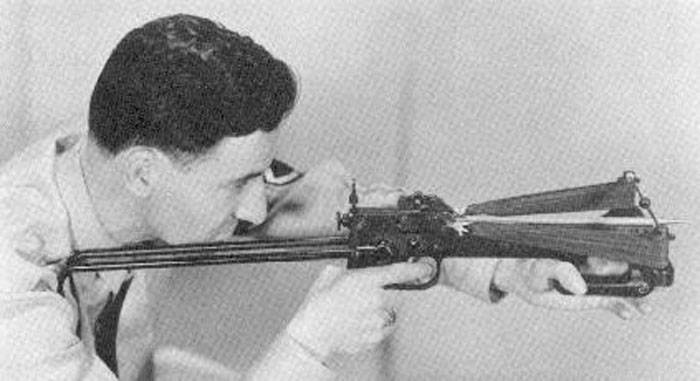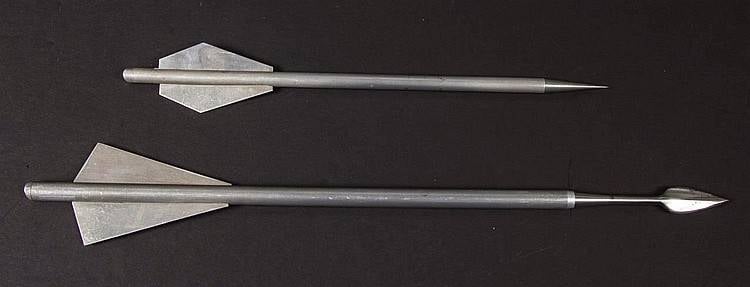William Tell Crossbow (USA)
The development of advanced weapons was carried out with the direct participation of OSS, and the specialists of this organization took the lead and carried out most of the design work. At various stages of development, some commercial organizations were involved in the projects. They were supposed to make experimental weapons, and in the future could master mass production. However, in the future, the secret service was disappointed in the original projects, and the industry did not have to master the production of new samples.
It should be noted that the crossbows for OSS fighters were such only in name. From the point of view of their design, they were not similar to traditional crossbows, and they were based on the idea of a slingshot. The energy for throwing the boom was not stored in the flexible arms, which were bent during tension of the bowstring, but in the rubber harnesses mounted on a rigid frame. However, the developers of the new weapon have designated it as “crossbow”, and not as “slingshot”.
Within the framework of the new family of special weapons, it was proposed to create several samples with different technical, combat and operational characteristics. The largest example of this line was the product Big Joe 5. A smaller crossbow and, as a result, not so powerful and long-range, was to become a crossbow under the working title of William Tell. It is curious that this was the only development of a new family, the name of which could hint at its essence. The weapon was named after the legendary crossbowman William Tell.
The William Tell project offered the manufacture of compact folding weapons capable of sending a metal boom to a distance of several dozen yards. From the point of view of some of the main features of the design, such a crossbow was similar to the “Big Joe No. XXUMX”, however, there were very serious differences. In particular, a different design of the box with a frame for the installation of rubber harnesses was proposed and implemented. Due to this, we managed to get rid of the complex overall unit used on the larger sample.
The main part of the new weapon was a metal box with mounts for all major devices and parts. She had a T-shaped in terms of form. The front transverse crossbar was intended for the installation of rubber harnesses and was a kind of analogue of the shoulders of a traditional crossbow. On top of the bed were all the main devices responsible for the acceleration of the bolt-arrow, cocking and lowering. Bottom positioned a pair of arms to hold the weapon, as well as the trigger under the protective bracket. Behind the bed joined folding bottom.
"William Tell" and other developments of the Office of Strategic Services did not have flexible arms, and the functions of energy collection were assigned to rubber bands. On the sides of the front transverse crossbar of the box, a pair of vertical supports were installed, connected by a thin horizontal tube from above. Such a design could show sufficient rigidity and withstand the loads arising during the cocking of the weapon.
On each of the vertical supports were placed several dozen rubber rings of small diameter. On the other side of the rings was a fishing line or wire, collecting them into a single unit. With the help of a fishing line, a rubber band was connected to the moving block of the crossbow, which was responsible for acceleration of the bolt. The presence of two harnesses, located to the right and left of the weapon axis, made it possible to increase the initial speed of the boom, as well as to reduce the dimensions of the product within reasonable limits.
The bolt acceleration, as in the case of the Big Joe 5, was proposed to be carried out with the help of a movable block moving along the guides of the box. In front of this unit was a saddle for contact with the shank for contact with ammunition. Behind it had the means for cocking and locking in the rearmost position to prepare for the shot. Unlike the more powerful “Big Joe,” the smaller crossbow did not need mechanisms for stretching rubber rings — the reloading could be done manually.
Behind the box was placed a metal casing that contained the details of the trigger mechanism. William Tell's crossbow got a trigger similar to firearm devices. Clicking on it led to unlocking the movable block with its subsequent displacement and ejection of the bolt. After each shot, the weapon needed manual reloading with a new stretching of the harnesses and the installation of the next arrow.
Designers from the Office of Strategic Services used on their crossbows an interesting version of sighting devices. On the upper front transverse tube that connected the racks with rubber rings, there was a small ball that served as a fly. On the cover of the rear casing, a vertical base was placed with the whole unregulated. For transport, it could fold and fall on the cover of the casing.

OSS officer demonstrates the principles of using "William Tell"
The crossbow had acceptable ergonomics, providing sufficient ease of use. Behind the box was a pistol grip, next to which a trigger was placed. The front provided for a rather long U-shaped grip. It could provide an acceptable convenience for holding weapons, but it did not take up much space and was not distinguished by the complexity of production.
Also, the project involved the use of a folding stock. We used the simplest product of thick wire, which had front ledges for fixing on the bed and a rear vertical shoulder rest. When carrying the weapon, the butt folded forward and down, after which it was fixed on the bottom of the bed, and the shoulder rest was facing the crossbar with rubber straps.
With the William Tell crossbow, it was proposed to use a metal arrow-bolt of a characteristic look. It was based on a long metal shaft with a pointed head. Behind such a pole were the feathers of the stabilizer. Overall boom length - 10 inches (mm 252). The mass of the product was only 0,8 ounces (22,7 g) and corresponded to the potential of the rubber rings.
For the new OSS crossbows were developed different arrows, which had different purposes. First of all, military arrows were created, capable of striking manpower - sentries at the post or guard dogs. In addition, special munitions were being designed. For example, it is known about the development of a bolt with a pyrotechnic composition designed to illuminate the terrain. Apparently, in the dimensions of the bolt for the "William Tell" it was impossible to create a special-purpose arrow, and this weapon was to be used only ammunition to defeat the enemy.
By using a different harness attachment system that did not include long side struts, the William Tell crossbow was a bit smaller and lighter than the Big Joe 5. The total length of the weapon did not exceed 350 mm with the butt folded. With the butt spread out, the length reached 620-630 mm. The mass of the crossbow is 3,33 pounds (about 1,5 kg).
Reduction in size led to a decrease in the number of rubber rings in the composition of harnesses and to a corresponding drop in combat performance. According to some reports, the “William Tell” could send a bolt at a distance of no more than 100-150 m - almost half the size of the “Big Joe”. However, the light arrow retained a killer action at distances of no more than 30-40 m, and its real capabilities depended on many different factors.
Approximately at the end of 1942, the Office of Strategic Services produced a number of experienced crossbows of several new models and sent them to the test. It was planned to check the weapons at the test site, and based on the results of such a check, determine its further fate. Upon receiving the desired results, crossbows could enter into service and expand the capabilities of special forces in the cause of silently fighting the enemy.
As far as we know, the tests continued until the beginning of the 1943 of the year and ended with not the best conclusions. It was found that several products presented, in general, are capable of solving the assigned combat missions. At the same time, they had a number of characteristic flaws or ambiguous features that seriously impeded combat use. In other conditions, these shortcomings might have been considered acceptable, but by that time, the OSS already had a convenient alternative in the form of silent small arms. This predetermined the future of all new developments, including the William Tell product.

Bolts for William Tell (above) and Big Joe 5 crossbows (below)
When firing, special crossbows made no more than 80 dB noise - significantly lower than pistols with noiseless firing devices. In addition, unlike pistols, they could use not only combat bolts, but also auxiliary arrows. However, on this the advantages of throwing weapons over firearms ended. For different parameters and features, crossbows almost always lost to alternative systems.
The “William Tell” differed from the “Big Joe” in reduced dimensions, which, first of all, was due to a different design of fastening means for harnesses. However, after that, he was significantly larger than existing pistols with silencers, such as Hi-Standard HDM. In addition, it differed from firearms in a less convenient form, which also hampered transportation.
A characteristic problem of all crossbows was the need for long reloading after each shot. Having fired an arrow, the fighter had to perform a number of necessary procedures, and only after that it was possible to make a new shot. You can imagine what problems in this case could result in a miss when fired. In fact, the fighter had no chance to prepare a weapon for the second shot. Pistols of existing structures, in turn, had store supply and reloaded themselves, allowing you to immediately make a new shot.
By the combination of characteristics and combat qualities, crossbows were not of particular interest to the special services. As a result, already at the beginning of 1943, shortly after conducting the ground tests, the management of the Office of Strategic Services ordered the curtailment of work in this direction. Self-loading pistols equipped with integral silencers or other firearms of similar appearance were now to become the main means of silently eliminating enemy personnel.
To test the 1942-43, several experienced crossbows were made, including a certain number of William Tell products. After completing the tests with a negative conclusion, their fate was predetermined. In the future, much of these crossbows were disposed of as unnecessary. As far as is known, none of the “William Telli” survived to our times. In addition, there were, to put it mildly, not too many photographs of such weapons.
To perform special operations, the OSS fighters might need special weapons capable of solving the set task with minimal noise. A promising answer to this question was a throwing weapon capable of quietly sending a heavy pointed arrow to the target. However, in practice it turned out that such a weapon - with only a few advantages - has a lot of disadvantages. As a result, the entire line of unusual designs, including the William Tell crossbow, did not receive recommendations for adoption. However, she stayed in stories as an example of non-standard approaches to solving specific problems.
On the materials of the sites:
http://weaponsman.com/
http://thetruthaboutknives.com/
http://usmilitariaforum.com/
http://slingshotforum.com/
OSS Weapons: Special Weapons and Devices. Washington: Special weapons and devices research and development branch OSS, 1944.
- Ryabov Kirill
- OSS Weapons: Special Weapons and Devices, Invaluable.co.uk

Information